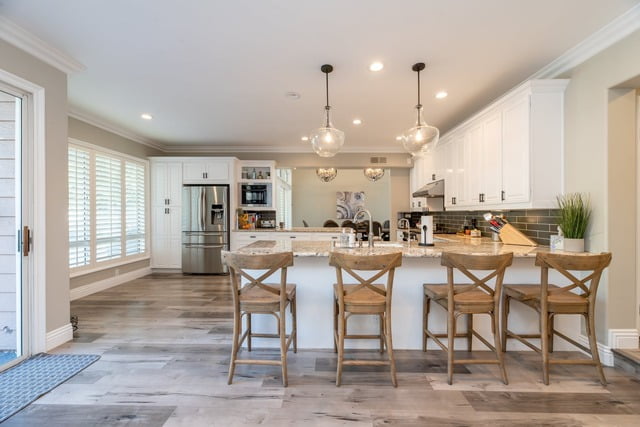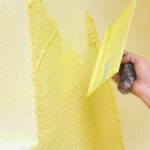Is it possible to refinance your house in order to fund those long-awaited home improvements? This question is on the minds of many homeowners looking to enhance their living spaces. In this article, we will explore the benefits of refinancing your house for home improvements and provide you with a comprehensive guide to help you make an informed decision.
When it comes to financing home improvement projects, refinancing can offer several advantages. By refinancing your house, you have the opportunity to secure funds that can be used to renovate, upgrade, or expand your property. This can not only increase your comfort and enjoyment of your home but also potentially add value and equity.
Understanding how refinancing works is crucial before considering this option. We will delve into the details of what refinancing means for homeowners and how the process functions. Additionally, we will guide you through evaluating your home improvement needs – identifying the specific areas you want to enhance and assessing their financial impact.
Through exploring various loan options specifically tailored for home upgrades, you will gain insight into whether or not you can refinance your house in order to secure funds for these improvements. We’ll provide real-life success stories from homeowners who have utilized refinancing for home upgrades, as well as a step-by-step guide on how to navigate the refinancing process.
Ultimately, our aim is to empower homeowners like yourself with knowledge so that you can make informed decisions regarding whether refinancing your house for home improvements is the right choice for you. So let’s dive deeper into this beneficial option that could transform your living space into the dream home you’ve always wanted.
Understanding Refinancing
Refinancing is a financial term that homeowners often hear but may not fully understand. This section will demystify the concept of refinancing and explain how it works specifically for homeowners looking to fund home improvements.
Definition and Purpose of Refinancing
Refinancing involves paying off an existing mortgage with a new one, typically with better terms such as lower interest rates or more manageable monthly payments. The primary purpose of refinancing is to save money, but it can also serve other objectives, such as accessing cash for large expenses like home improvements.
How Refinancing Works for Homeowners
When you refinance your house for home improvements, you essentially take out a new loan that covers both your outstanding mortgage balance and the additional funds you need for renovations. The new loan pays off your existing mortgage, leaving you with a single loan that typically has more favorable terms or added funds to invest in enhancing your home.
To determine whether refinancing is a viable option for your home improvements, several factors come into play. These factors include your credit score, current interest rates, the equity you have in your home, and the potential increase in property value resulting from the upgrades.
In most cases, borrowers need to meet certain requirements established by lenders before they can refinance their homes. These include having sufficient income to support the new loan payments and meeting minimum credit score thresholds. It’s crucial to carefully assess your financial situation and consult with lenders or financial advisors to determine if refinancing is a feasible solution for funding your home improvement projects.
Evaluating Your Home Improvement Needs
Identifying the areas you want to enhance for home improvements is an essential step before considering refinancing your house. By evaluating your home improvement needs, you can determine which areas of your home require upgrades and renovations and understand their financial impact. This section will guide you through the process of assessing your home improvement needs and understanding how they will affect your finances.
Evaluating Your Home Improvement Priorities
Before embarking on a home improvement project, it’s important to identify your priorities. Take some time to evaluate which areas of your home are in need of improvement and determine the order in which you would like to tackle them. Start by making a list of all the potential renovations or upgrades you want to undertake, whether it’s a kitchen remodel, bathroom renovation, or adding an extension to your living space.
Consider factors such as functionality, aesthetics, and long-term value when prioritizing your needs. For example, if you plan on selling your house in the near future, focusing on projects that increase curb appeal or improve energy efficiency might be a wise choice. On the other hand, if you intend to stay in your home for an extended period, prioritize improvements that will enhance your day-to-day living experience.
Assessing the Financial Impact
Once you have identified the areas you want to enhance through home improvements, it is crucial to assess their financial impact. Researching the average costs associated with similar projects can help you estimate how much money it will take to accomplish your goals. Consider getting quotes from contractors or conducting online research to get a better understanding of price ranges.
Next, evaluate how these improvements may affect the value of your property. Some renovations may provide a high return on investment (ROI), while others may not yield significant financial gains. Analyze real estate market trends and consult with real estate professionals or appraisers who can offer insights into local market conditions and predict the potential increase in your home’s value.
Remember to create a budget for your home improvements, including all related expenses such as materials, labor costs, permits, and unexpected contingencies. This will give you a clear idea of how much funding you need for your projects.
By evaluating your home improvement needs and understanding their financial impact, you can make informed decisions about whether refinancing your house is the right choice for funding these projects. It is important to have a clear understanding of the costs involved in order to determine if refinancing is a viable option.
Assessing the Possibilities
When considering whether or not to refinance your house for home improvements, it is important to assess the possibilities and determine if this is a viable option for you. This section will explore the factors that can affect your ability to refinance your house and secure funds for your desired home upgrades.
One key factor to consider is the current market value of your home. Lenders typically require an appraisal before approving a refinance loan. If your home has significantly increased in value since you purchased it, this could work in your favor as it may enable you to borrow more against the equity in your home. On the other hand, if the value of your home has declined or remained stagnant, it may be more challenging to secure funds through refinancing.
Additionally, lenders will evaluate your credit score and financial history when determining if you are eligible for a refinancing loan. A good credit score demonstrates responsible financial management and makes you a lower risk borrower. It can also positively impact the interest rate you are offered on the loan. If your credit score is less than stellar, take steps to improve it before applying for a refinancing loan.
Finally, consider the amount of equity you have built up in your home. Equity is the difference between the current market value of your property and how much you still owe on any existing mortgages. The more equity you have, the greater likelihood of being approved for a higher loan amount when refinancing.
Keep in mind that lenders typically have maximum loan-to-value (LTV) ratios they are willing to lend against, often ranging from 70% to 90%. So while having equity is important, it’s also crucial to understand the lender’s LTV requirements.
| Factors to Consider | Impact on Refinancing Possibilities |
|---|---|
| Current Market Value of Your Home | If the value has increased, it may be easier to secure funds. |
| Credit Score and Financial History | A good credit score improves eligibility and may result in better loan terms. |
| Equity in Your Home | Having more equity can increase your chances of approval and borrowing larger amounts. |
Exploring Loan Options
Refinancing your house for home improvements can be a smart financial move, but it’s important to understand the different loan options available to homeowners. When considering refinancing, there are several options specifically tailored for home upgrades that you should explore.
One option is a cash-out refinance. With this type of loan, you can borrow more than what you owe on your current mortgage and use the extra funds to finance your home improvements. This can be a great choice if you have built up equity in your home and want to take advantage of low interest rates. However, it’s important to carefully consider whether the additional debt is manageable for your budget in the long term.
Another option is a renovation loan. These loans are designed specifically for homeowners who want to make significant renovations or improvements to their property. Renovation loans often come with flexible terms and may include lower interest rates than traditional home improvement loans. They can be a good choice if you have specific renovation plans and want to finance them separately from your existing mortgage.
A third option to consider is a home equity line of credit (HELOC). A HELOC allows you to borrow against the equity in your home as needed, making it a flexible financing solution for ongoing or future home improvement projects. The interest rates on HELOCs are typically variable, so it’s important to carefully consider how changes in interest rates could impact your monthly payments.
Before deciding on a loan option, it’s crucial to evaluate your financial situation and determine which one aligns best with your needs and goals. Consider factors such as interest rates, fees, repayment terms, and potential tax benefits when comparing different loan options. Consulting with a financial advisor or mortgage professional can also provide valuable guidance in choosing the right refinancing option for your home upgrades.
The Refinancing Process
Refinancing your house for home improvements can be a great way to unlock the potential of your property and make the changes you’ve always wanted. However, before diving into the refinancing process, it’s important to understand the steps involved and how they can help you achieve your goals. This step-by-step guide will walk you through the refinancing process for home improvements.
- Assess your current mortgage: The first step in refinancing your house is to evaluate your current mortgage situation. You’ll need to determine how much equity you have in your home, as this will determine how much you can borrow for your home improvements. Additionally, it’s important to review your current interest rate and loan terms to see if refinancing makes financial sense.
- Research lenders: Once you’ve assessed your current mortgage, it’s time to research different lenders and explore their refinancing options. Look for lenders that offer competitive interest rates, flexible terms, and favorable loan conditions. It’s also a good idea to compare fees and closing costs associated with each lender to ensure you’re getting the best deal possible.
- Gather necessary documents: Before applying for a refinance, gather all necessary documents that lenders may require during the application process. This typically includes income verification, tax returns, bank statements, and any other documentation relevant to your financial situation. Having these documents on hand will streamline the application process and expedite approval.
| Step | Description |
|---|---|
| 1 | Assess Your Current Mortgage |
| 2 | Research Lenders |
| 3 | Gather Necessary Documents |
Successfully refinancing your house for home improvements requires careful consideration and planning. By following this step-by-step guide, you’ll be better equipped to navigate the refinancing process and secure the funds needed to enhance your home. Remember to consult with professionals, such as mortgage brokers or financial advisors, who can provide personalized advice based on your specific situation.
Maximizing the Potential
Refinancing your house for home improvements can be a great opportunity to not only enhance the value and comfort of your home, but also potentially save money in the long run. However, in order to maximize the potential of your refinancing loan, it’s important to have a solid plan and implement effective strategies. Here are some tips and strategies to help you get the most out of your refinancing loan:
- Prioritize Your Home Improvement Needs: Before jumping into refinancing, take some time to evaluate your home improvement needs and prioritize them accordingly. Make a list of the areas you want to enhance and determine their financial impact. This will help you focus on the most important projects and allocate funds accordingly.
- Research Loan Options: When considering a refinancing loan for home improvements, it’s crucial to explore different loan options available specifically tailored for this purpose. Familiarize yourself with options such as cash-out refinancing or renovation loans, which allow you to borrow against the equity in your home for renovations.
- Plan Your Budget Wisely: Once you have identified your home improvement needs and researched loan options, it’s time to plan your budget wisely. Create a detailed budget that takes into account not only the renovation costs but also other expenses such as closing costs, fees, and potential increases in monthly mortgage payments. It’s important to have a clear understanding of how much you can afford before proceeding with the refinancing process.
- Work with Professionals: Refinancing for home improvements can be complex, so working with professionals such as mortgage brokers or financial advisors can be incredibly beneficial. They can guide you through the process, help you find the best loan options, negotiate favorable terms, and ensure that everything is done correctly.
- Use Trusted Contractors: When using funds from your refinancing loan for home improvements, it’s essential to choose trusted contractors who will deliver quality work within your budget. Do thorough research, ask for recommendations, and interview multiple contractors before making a final decision. That way, you can ensure that your money is being used effectively and efficiently.
By following these tips and strategies, you can maximize the potential of your refinancing loan for home improvements. Remember to always analyze your options, plan diligently, and work with professionals to make informed decisions that align with your goals as a homeowner. With careful consideration and strategic thinking, you can transform your house into the dream home you’ve always envisioned.
Financial Considerations
When considering refinancing your house for home improvements, it is important to weigh the potential pros and cons before making a decision. This section will explore the financial considerations involved in this decision-making process.
Pros of Refinancing for Home Improvements
- Lower Interest Rates: One of the main advantages of refinancing is the opportunity to secure a lower interest rate. By obtaining a new mortgage with a lower rate, you can potentially save money on your monthly payments, which can free up funds that can be used towards home renovations.
- Access to Cash: Refinancing may allow you to access the equity in your home. This means that if your property has appreciated in value since you initially purchased it or last refinanced, you could potentially borrow against that equity and receive cash to finance your home improvements.
- Tax Deductions: In certain cases, the interest paid on a refinanced mortgage may be tax-deductible. Consult with a tax professional to determine if you are eligible for any deductions based on your specific circumstances.
Cons of Refinancing for Home Improvements
- Closing Costs and Fees: Refinancing typically involves closing costs and fees, which can include appraisal fees, application fees, origination fees, and more. These costs can add up and should be factored into your decision-making process when considering whether or not to refinance.
- Incurring More Debt: When refinancing for home improvements, you are essentially taking on additional debt by increasing your mortgage amount. This means that over time, you may end up paying more in interest as well.
- Risk of Overimprovement: It is important to consider the potential resale value of your home after completing the renovations. If you invest a significant amount into improvements that do not significantly increase your home’s value, it may be challenging to recoup that investment when it comes time to sell.
By carefully evaluating the pros and cons outlined above, you can make an informed decision about whether refinancing for home improvements is right for you. Remember to consider your specific financial goals, the current interest rate environment, and the potential increase in property value when weighing these factors.
Success Stories
Refinancing your house to fund home improvements is not just a theoretical concept – many homeowners have successfully taken this route and achieved their desired upgrades. These success stories serve as inspiration for those considering refinancing as a means to enhance their homes.
One such success story is Sarah, who had been dreaming of renovating her outdated kitchen but didn’t have the funds to cover the project upfront. Through refinancing her house, she was able to access the equity she had built up over the years and secure a loan specifically designated for home improvements.
With these funds, Sarah not only transformed her kitchen into a modern, functional space, but also added value to her home in the process. The increase in her property value made her investment worth it.
Another example is Mark, who wanted to add an extra bedroom and bathroom to his home due to a growing family. He explored various financing options and found that refinancing offered him the lowest interest rate and most favorable terms.
By refinancing his house, Mark was able to secure the necessary funds to complete the addition and accommodate his expanding family comfortably. Not only did he achieve his desired home upgrade but he also saved money on interest payments compared to some other loan options.
These success stories highlight how refinancing can be an effective tool for homeowners looking to finance home improvements. By accessing the equity in their homes, individuals like Sarah and Mark were able to realize their renovation goals without depleting their savings or opting for higher-interest loans. It’s important for prospective borrowers considering refinancing for home upgrades to educate themselves about the process and consult with mortgage professionals who can help evaluate their unique financial situations.
Overall, these real-life examples demonstrate that refinancing can provide homeowners with successful outcomes when it comes to achieving their desired home upgrades. It empowers them financially by unlocking the potential stored within their homes and helps transform their dreams into reality. By learning from these success stories and understanding the refinancing process, homeowners can make informed decisions and embark on their own journeys to enhance their homes.
Conclusion
In conclusion, refinancing your house for home improvements can be a beneficial option for homeowners looking to enhance their living spaces. This article has provided an in-depth exploration of the benefits of refinancing, how it works, and the steps involved in the process. By evaluating your home improvement needs and exploring different refinancing options, you can secure funds specifically tailored for upgrading your home.
One key takeaway from this article is that refinancing allows homeowners to tap into their home’s equity to fund their renovation projects. This can be a cost-effective way to finance upgrades without taking on additional debt. Additionally, by choosing the right loan option and understanding the refinancing process, you can make informed decisions that align with your financial goals.
It is important to consider the pros and cons of refinancing before making a decision. While refinancing can provide access to funds for home improvements, it also comes with associated costs such as closing fees and potentially higher interest rates. Therefore, it is crucial to weigh these financial considerations against the potential benefits that come with enhancing your home’s value and comfort.
Ultimately, this article aims to empower homeowners by providing information and insights on how they can make informed decisions when considering refinancing for home improvements. By following the step-by-step guide outlined here and learning from real-life success stories, you can take control of your financial situation and create a more comfortable living space that meets your needs and preferences.
Frequently Asked Questions
Can home improvements be added to mortgage?
Home improvements can indeed be added to a mortgage through a couple of options. One common method is by securing a home improvement loan, which can then be used to fund the renovations or improvements. This type of loan is typically based on the value of your home after the improvements have been made, so it allows you to borrow against the increased equity.
Another option is to refinance your existing mortgage and include the cost of the home improvements in the new loan amount. This can be advantageous if you can secure a lower interest rate or better loan terms through refinancing.
Is it wise to use home equity for home improvements?
Using home equity for home improvements can be a wise decision depending on various factors. If you have built up significant equity in your home and have a clear understanding of how the improvements will increase its value, tapping into that equity may make sense. It allows you to access funds for renovations without taking out additional loans or increasing debt.
However, it’s important to consider the potential risks involved as well, such as fluctuating property values or overleveraging yourself financially. A careful evaluation of your financial situation and future plans is crucial before deciding whether using home equity for improvements is wise.
How does refinancing work for renovation?
Refinancing for renovation works by replacing your existing mortgage with a new loan that includes both the remaining balance from your original mortgage and additional funds needed for renovations. When refinancing for renovation purposes, lenders will generally lend based on the after-renovation value of your property rather than its current value.
The process involves assessing the costs and potential increased value resulting from the renovations to determine an appropriate loan amount. It’s important to carefully compare offers from different lenders while considering factors such as interest rates, closing costs, and repayment terms to ensure refinancing works effectively for your specific renovation goals and financial circumstances.

I’m thrilled to have you here as a part of the Remodeling Top community. This is where my journey as an architect and remodeling enthusiast intersects with your passion for transforming houses into dream homes.





